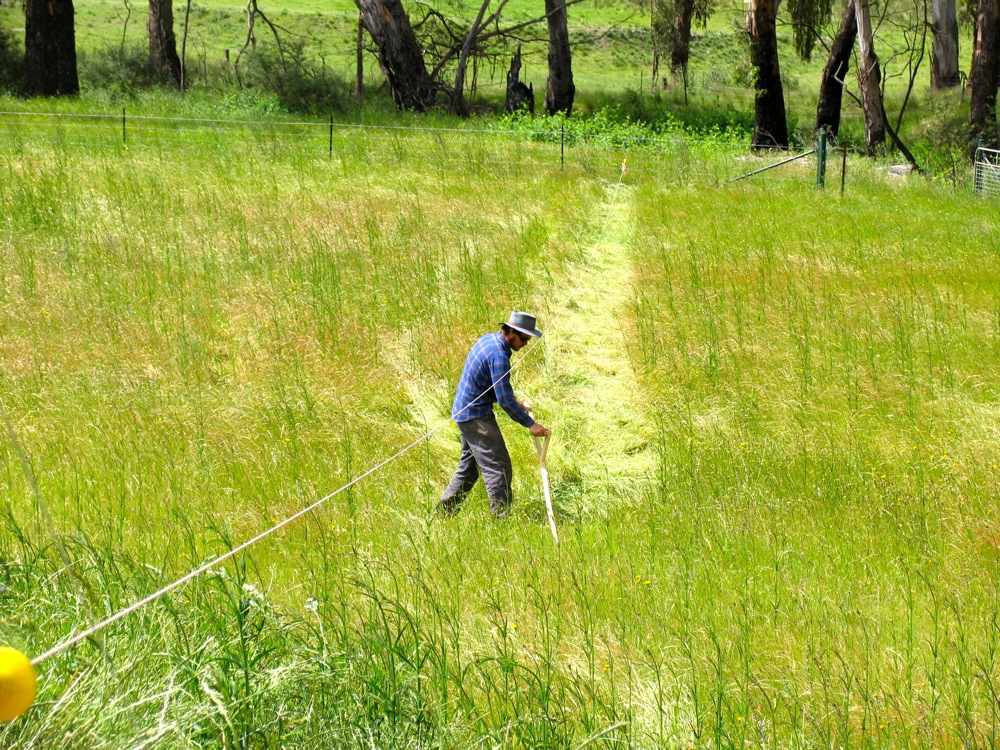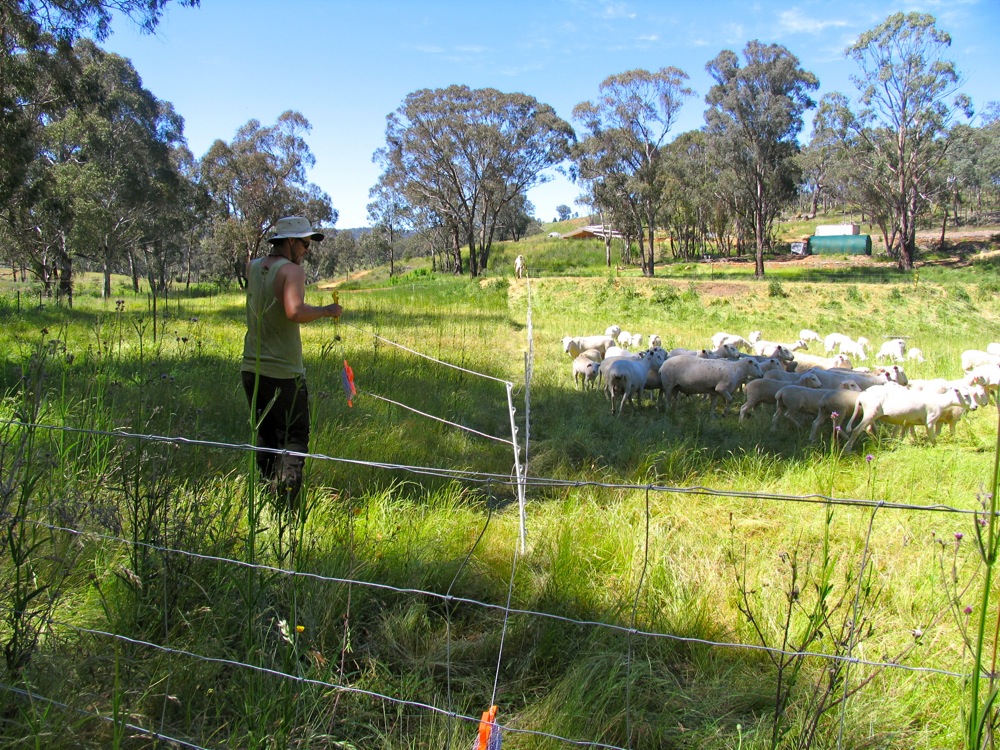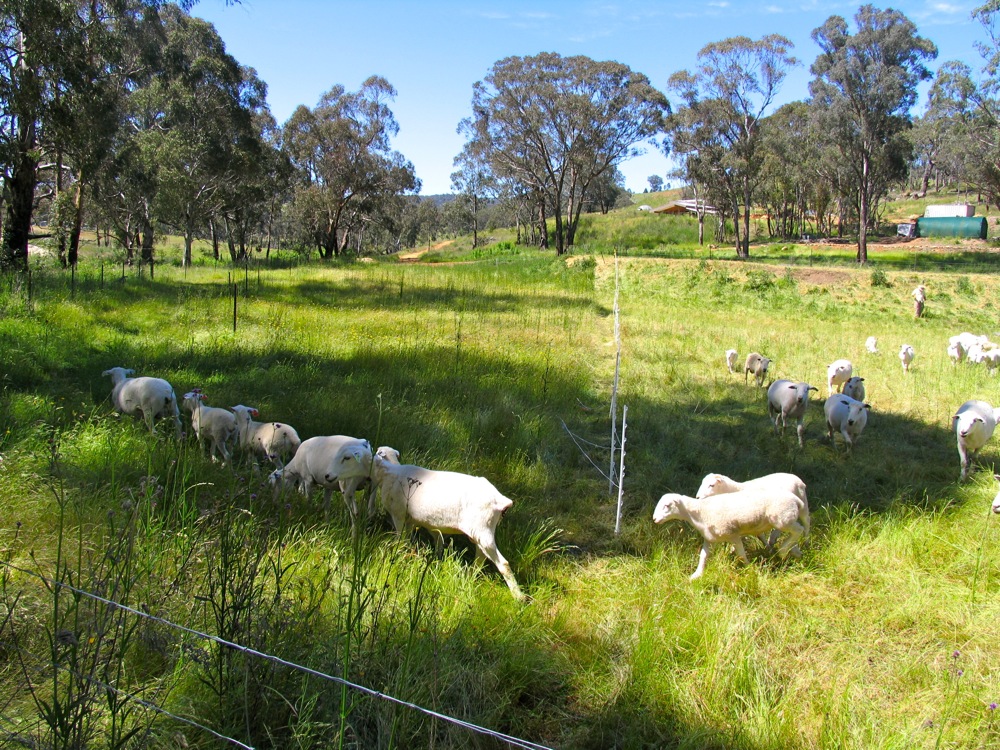
Flat ground. Seemingly simple, but oh so full of implications. We didn’t really think about how cool flat ground was until we calculated that it made up exactly 10% of the total landmass of Milkwood. That means 90% hilly bits. Hmm.
Flat ground is very precious – you can do all sorts of things with it which are just not suitable for steeply sloping ground. So we’ve been trying to figure out how best to use it. Main crop with hedgerows? Chook-clock market garden? Pastured poultry? Food forest?
While we’ve um-ed and ah-ed, the creekflat (our flat bit) has sat there patiently, covered in recovering pasture, being slashed occasionally, keyline plowed and seeded with vetch and oats, and waiting for our decision. A decision we’ve committed to leave until we’re moved into our tinyhouse, which will herald the next phase of Milkwood.
In the meantime, however, we thought we’d have a go at using some marvelous biological accelerators (herbivores) to make the most of this exceptionally wet year and the pasture growth that’s gone with it. That way we can build biomass on the creekflat while we decide what to do with it!

Panorama of entire creekflat, with sheep in the second cell. You can see the difference between the crash-grazed and un-touched cells. Click on image to enlarge for a better look
Since meeting Kirk Gadzia earlier this year, we’ve developed a deep and abiding respect for Holistic Management and the powerful implications that go with it. However, we do not manage 300 acres of pastured cattle and the infrastructure that goes with it. Could we still have a go at holistic management in miniature, with our limited resources?
Some would say Holistic Management techniques work best with herbivores that have 4 stomachs, soft feet and nice big sloppy manure. Namely cows. But we don’t have any cows. Yet. Our family farm next door has sheep though, so we’re using what we have, and making the best of what’s available.

Lots of sheep in a small space for a short period of time means the sheep eat a bit of everything, not just the plants they like. This is great for accelerating the pasture diversity.
Some would say sheep are not as ideal as cows for classic Holistic Management, for a couple of reasons. The primary one is their poo. A sheep expels pellets which don’t incorporate into the soil nearly as fast as a big sloppy cow-pat.
And then there’s their hooves. Much harder on the soil than a cows softer pads. And then there’s their stomachs. Cows have different biology in their gut from sheep: which means the grass that sheep eat is not as processed, digested and broken down as in a cow, which means it isn’t as ready to incorporate into the soil.
However, as said, sheep is wots we ‘ave. Ain’t got no cows. And they have their own advantages over cows in a Holistic Management setting: they eat different plants and contribute other biology. The sheep’s urine is also chock-full of beneficial minerals and nutrients for the pasture.
Both sheep and cows can be used to do the same basic job when it comes down to it: they eat the grass, process it into manure, deposit it back out and help accelerate the biology of that pasture by providing nutrient and stimulating the seedbank in the soil. So we thought we’d have a go at time-controlled grazing the creekflat with Nick’s parent’s sheep.
Time controlled grazing is the process of putting a lot of herbivores on a relatively small paddock of grass for a relatively short period of time, and then moving them on to a fresh bit of ground.
The idea here is that you are mimicking the behavior of a herding animal in the wild: a tightly packed herd (to protect themselves from predators) which moves across the landscape, not coming back to the ground they chewed and poo-ed on yesterday till far into the future.
When left for the right amount of time between grazing, the pasture recovers, and the seedbank within the soil is stimulated, and the biomass of the paddock, both above and below the surface, is drastically increased by this short sharp attack of grazing and the nutrient dump that comes with it.
The rule of thumb is that by the time you move those herbivores on to the next patch you want one third of the grass in their stomachs, one third laid down on the ground, and one third still standing.
From what we’re learning, successful Holistic Management is a synergy of time, space and life. A herd are moved across a landscape in a tight pack. The rate at which you move them depends on the weather, the time of year and the conditions of that paddock, all of which are variable. So this isn’t a formulaic process. You gotta use your noodle.
So how big to make the paddocks? How many sheep to use? How often to move them? We decided to use a combination of observation and good information to figure it out.
For this experiment, and based on Kirk Gadzia’s excellent student resources we divided up our 2 acre creekflat into 4 paddocks fenced with temporary electric fencing, based on the number of sheep we were using (95 or so). The idea being we would move the mob through these 4 cells at a rate determined by observation of the ‘three thirds rule’ as explained above.
We had enough electric fencing for one boundary fence (along the top of the bottom dam wall) and 2 paddock cells. The other boundary fence was already there in the form of our riparian fence along the creek. Now it was just a matter of setting up the first two cells, putting a mobile watering point in the first cell, and we were good to go.

The sheep in the second cell, with Campbells Creek in front. As you can see, this is a recovering riparian area that is benefiting from being fenced off from stock
Animals need access to water. Always. It sounds simple, but this basic point is partly responsible for some of the worst riparian erosion i’ve seen in the Australian landscape, in the form of allowing cattle and sheep access to rivers and creek beds instead of providing a simple watering point in the paddock and fencing the creek off. Herbivores are powerful agents of change in a landscape. They can do enormous harm when not managed well and thoughtfully. And they can help heal a landscape, too, when managed well and mindfully.
For this experiment we created a simple mobile watering point with a watering trough on wheels, a float valve, and a hosepipe running from the dam above the paddock into the bathtub. We created a siphon by putting the whole hose underwater in the dam, sealing one end and then dragging that end of the hose down to the watering point before releasing the seal and filling the trough. Once this was done, the watering system worked passively, thanks to good old gravity.
Floyd, Adam and Ryan set up the first two cells with our 4-strand electric fencing (with a solar-powered energizer on the dam wall), and then herded the 95 wiltipoll sheep into the first cell. The sheep didn’t need much convincing – they were more than happy to be let loose on a creekflat full of fresh pasture!
That evening we all trouped down to the flat, sat on the dam wall and watched the sheep below make short work of the grass they had access to. Much better than TV, especially with a sunset and a playful toddler to round out the view.
As it turned out, the sheep got moved every 24 hours, which seemed about right for the conditions and the number of sheep. So 4 days later, the experiment was done. We learned a lot of little tricks in the process which will help us next time. And it was definitely good to start small to get the hang of it, rather than commit to a large and costly system first off.
Thoughts and things worth sharing out of this experiment:
– Since we started off with grass a little higher that ideal, we had to scythe a path for the fence for each new section. This was so the grass didn’t connect with the fence strands and lessen the charge (and the effectiveness of the fence). This task would be negated in a fully fledged system because you would be coming back onto that grass before it was too high.
– Sheep need lots of strands (we used 4) of electric fence to be effectively contained! Because of their insulating wool, they don’t get the message sometimes when they press against the fence so you need multiple strands to make sure they get the idea if they touch the fence. With cows, you can use just one strand.
– I’ve been told that cows can be quickly trained to a cell-grazing regime (and therefore move obediently to the next cell immediately), however i didn’t think the sheep did too badly. By the 4th day they had the idea and galloped into the new cell of fresh grass as soon as we opened the fence.
– It was very interesting to see the sheep’s grazing patterns in the cell. They first, of course, ate the grass they liked best, but by the end of the 24 hours they were browsing on a wide range of herbs and plants they wouldn’t normally touch in a larger paddock. More minerals and diversity for them, broader pasture management for us. Win-win.
– The electric fencing gear we used for this setup was all from Thunderbird (a local Mudgee company). The solar-powered energizer was an SB40, and we also used Thunderbird’s tread in posts with 4 strands of their fence tape and insulators. We were really happy with their products.
Big ups to Milkwood interns Adam Kennedy for helping make this experiment happen, and Floyd Constable and Ryan Rutley for their excellent help with sheep wrangling!
**Post-experiment note: and what do you think happened a week after this experiment? A massive flood, that’s what! Our entire creekflat went underwater for a day (which hadn’t happened in 30 years). The result was that all the sheep’s nutrient were washed away and replaced by silt, debry and tree trunks.

Campbells Creek in flood across our creekflat, shortly after our grazing experiment, with intern Adam doing some rather fabulous pointing. Click image to enlarge
Oh well. Such is the nature of a creekflat. Thanks to this experiment and the use of temporary electric fencing, we now have a system that will let us crash-graze this creekflat every 3-4 months, regardless of 30-year floods. I will report back later in the year as to how the pasture changes as a result, but at time of writing the flat is already looking more diverse than I’ve seen it before, so the experiment is already working!





















Lucky you to have flat land! Flat land is prety rare in our part of the world!!! We are looking at doing something similar with a mixed herd of goats, alpacas and probably a house cow. And following with our chooks. I love this way of farming, and am looking forward to putting it into practice. Bugger about the flooding though, but at least you can redo the experiment, and you have learnt lots I’m sure!
I had some fabulous discussions with john champagne regards ‘crash-grazing’ whilst undertaking my PDC…. as a long-term farmer I’m quite familiar with the process and have been cell-grazing (I think using ‘crash’ may give a nasty impression of what’s really going on!) for more than 20 years…. now throughout the drought (the ten year period up to last year) it was, of course, impossible to cell-graze…. it was impossible to graze – period! (we were supplementary hand-feeding our beefy boys and girls) – but now with grass in our paddocks again – well we will be going back to business!… Read more »
Thanks so much for posting, always interested to hear about cell grazing sheep as all the info online focusses on cattle. And excellent to get the details on the type of electric fencing used.
Flick 🙂
PS But I dunno about sheep being monogastric – I believe they have the 4 chambered stomach like all the other ruminants.
Hi Flick – yes I just got corrected on the stomach thing and have changed it. whoops. fixed now!
Thanks for the post. Great read.
I’d love for you guys to do an update on all your dams and hydrology. You had some really interesting ideas during the dry spell and I’m keen to see how it all worked once you added water.
Thanks,
Garth
Good idea, Garth. Coming right up.
Hi Nick, I am about to start doing this myself. I am discovering no diversity except for weeds which give photosensitivity to sheep so am supplementing with lucerne and oaten hay. A local biodynamic farmer uses cocksfoot, phalaris, chickory white clover and others in his mix to improve the pasture. Fiona